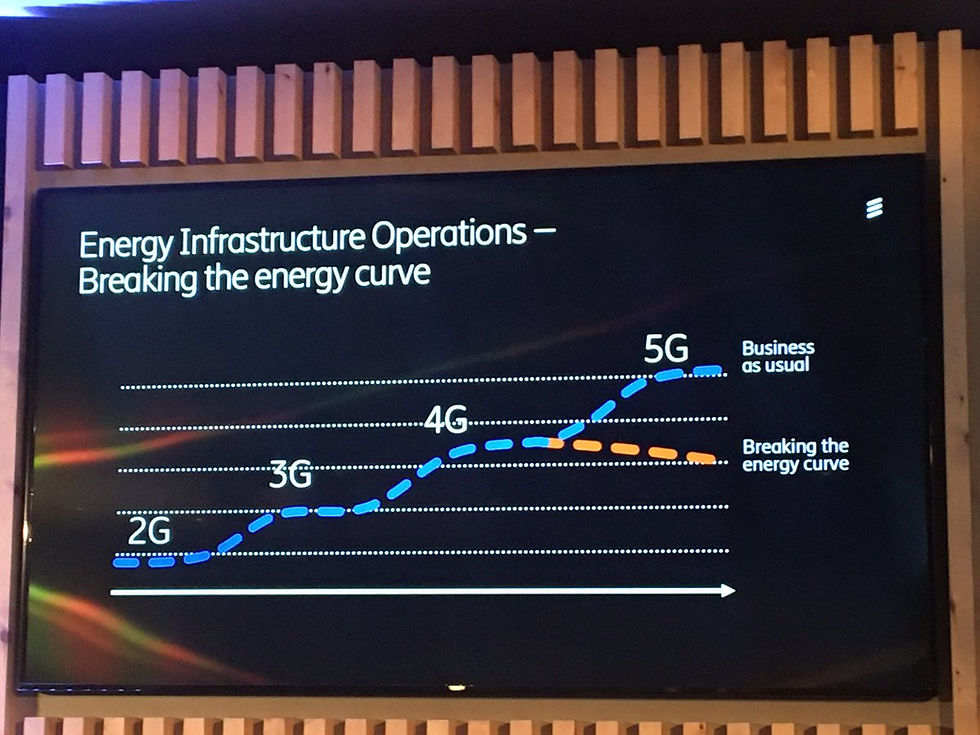Ericsson’s ‘Massive’ Move to Break the Energy Curve
- Sarah-Jayne Gratton

- Jul 8, 2021
- 3 min read
Sustainability shouldn’t be an option – it’s our moral responsibility.
And, as we journey into a 5G connected world the above statement becomes more relevant than ever. Energy efficiency needs to be a required standard to the solutions we develop, to ensure a green and sustainable future for the planet. Indeed, new system architectures should evolve previously established legacy industry standards and their specifications,

Over the past few years, I’ve been particularly impressed by examples of deployment strategies using different topologies of cells, distributed antenna systems and base station interoperation. Especially heterogeneous network deployments, where small cells are deployed under an umbrella macro cellular coverage.
In order to manage our future capacity demands in terms of bandwidth and to accommodate the vast of amount of devices each creating data, it is expected that considerably more ultra-dense deployments will be necessary.
These can however play a ‘green’ role in connectivity, in areas where extremely high data rates and capacity are needed, for example in heavily populated indoor locations, such as enterprise centres, shopping malls, and subway stations.
Small cells can be located indoors, where they are proven to be beneficial from an energy consumption perspective, due to their generous coverage in such localised areas.
A recent report by Ericsson ‘Breaking the Energy Curve’ highlighted the importance of taking an holistic approach to break the increasing energy consumption curve of mobile networks.
It’s a thought-leadership topic and one that dives deep into the ways that innovation coupled with new ways of thinking about how we use our digital infrastructure can provide essential solutions to reduce energy consumption in other sectors.
Fredrik Jejdling, Executive Vice President and Head of Business Area Networks at Ericsson recently discussed how “if we were to take a baseline from 2016 to today, we would see around a 10 times energy efficiency per byte advantage”
The evolution of radio solutions along with improved connectivity between mid-band/high-band and low bands means that Ericsson are managing to maximise spectrum resources whilst minimising energy usage. For example, their Massive MIMO (Multiple Input, Multiple Output) solutions, powered by Ericsson Silicon, are true enablers of the 5G era by utilising multiple antenna arrays and spatial diversity to create multiple transmission channels.
By increasing the number of channels within the available spectrum, network capacity is boosted and faster data throughput to each individual user is achieved. As a result, the solutions offer unrivalled energy efficiency and performance, while providing low total cost of ownership per delivered gigabyte.
Ericsson are taking a four-pronged approach to 'breaking the curve,' which comprises:
Modernizing the network with the latest technology
Activate energy-saving software
Build 5G with precision
Operating site infrastructure intelligently using Artificial Intelligence (AI)
“By deploying artificial intelligence right at the pulse of the network, communications service providers can realize energy efficiencies on the radio network proactively,” explained Bradley Mead, Head of Network Managed Services at Ericsson.
“It [AI] offers the potential to not only address site-related energy savings, but also operational efficiencies. For example, to reduce the number of site visits to increase the efficiency of resources and reduce operational CO2 emissions.”
Ericsson’s commitment to achieving maximum efficiency with minimum energy usage is about to get very exciting
Recently, Ericsson launched its very first service offering in this area, and likely the very first offering of its kind on the market.
The new Energy Infrastructure Operations (EIO) is an energy management solution that uses artificial intelligence and advanced data analytics to optimize energy consumption across the entire network infrastructure. Making operational systems more data driven is a great way to ensure that AI-enabled systems are playing a part in reducing energy output in future operations.

Partnership has always been one of Ericsson’s greatest strengths and they champion new routes to achieving carbon-zero innovation through collaboration. They are eager to support their customers in achieving their own green journey to meet the 2030 targets that have been set.
5G has yet to fully impact upon the ways we all live and work, but the potential brought about by Ericsson’s commitment to achieving maximum efficiency with minimum energy usage is about to get very exciting.
“5G is the most energy efficiency standard to handle the traffic in the market,” continued Jejdling.
“On a run-rate basis, we add around 1m 5G subscriptions every day during 2021. It’s the fastest growing adoption of them all.”
Find out more here.
This is a sponsored post on behalf of Ericsson





Comments